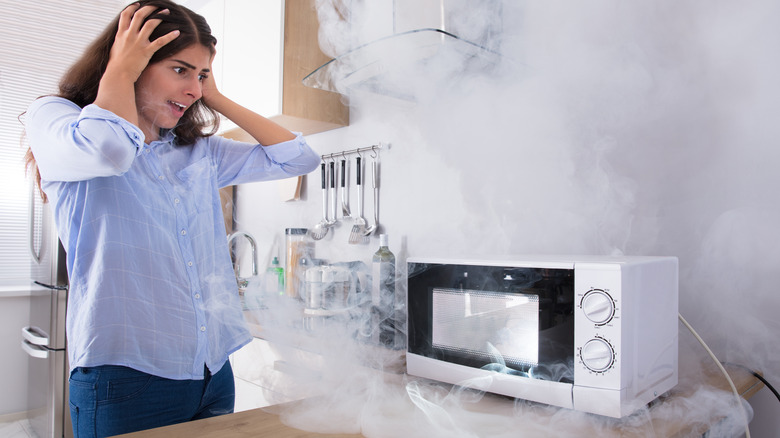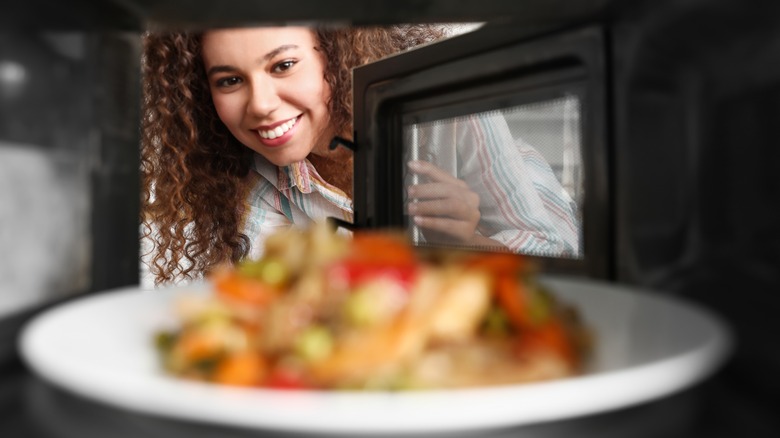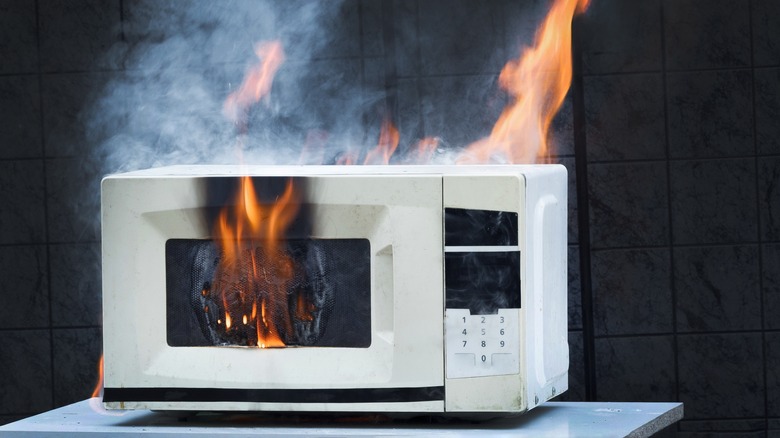Think Twice Before Putting These Household Items In Your Microwave
It feels like microwave ovens have been around since, well, forever, and the truth is, they weren't widely used in American homes until the 1970s. Invented accidentally in the 1940s by a Raytheon engineer, Percy Spencer, it took 20 years to perfect the microwave for home use. The first one, the Amana "Radarange," was introduced in 1967. Building steam in popularity, by the mid-1970s, a million units were sold each year. Now, about 90% of households in the United States have this convenience readily available, according to Popular Mechanics.
From heating a snack — like that Raytheon employee who inadvertently discovered the method back in 1946 — to cooking side dishes for a whole family, microwaves have become a daily-use appliance in many homes. Microwave users have found, however, that the types of containers chosen can make or break the success of heating food. There are some that are perfectly safe and others to most definitely avoid.
Things you shouldn't put in microwaves
One of the main areas of ambiguity regarding microwaving is reheating leftovers. While you might get away with heating some Styrofoam and cardboard containers in a microwave, not all are safe, so transferring food to another dish is preferable. Most modern glass and ceramic items are okay to put in the microwave. Looking for microwave-safe wording on the bottom of all types of containers is advisable. If you don't see that verbiage, then don't risk it.
Also, avoid microwaving household items like brown paper bags since they're not made to be heated to high temperatures. Most other paper goods are okay, though, including paper towels or napkins, typically used to cover dishes to keep them from exploding in your microwave. Paper plates are also good to go along with wax and parchment papers, according to Microwave Ninja.
Plastic containers are on the fence in terms of microwaving. While they haven't been officially deemed unhealthy by the U.S. Food and Drug Administration (FDA), if labeled for this use, environmental scientists suggest that heating edible substances in plastic containers in the microwave can cause chemicals to transfer to food. For this reason, transferring food to a glass container or microwave-safe plate is becoming increasingly advisable before heating it in a microwave.
Items deemed completely unsafe for use in microwaves
The most important thing to keep in mind when microwaving is to avoid using metal containers or implements of any kind, including copper, iron, steel, and aluminum. That means no aluminum foil, and don't forget to take metal utensils off plates before sticking them in the microwave. For one thing, using metal in a microwave negates the effect that heats your food, according to the MIT School of Engineering. Even worse — metal can cause appliance-damaging sparks or fires when microwaved.
When are glass and ceramics unsafe for microwave use? Lead crystal and glass with metallic trim are both no-no items. Some ceramics, especially hand-crafted pottery, have glazes containing metals, making them unsafe. If you enjoy collecting vintage kitchenware, keep in mind that things made before the early 1970s weren't produced with this heating method in mind. It's best to keep them out of the microwave to avoid damaging the container and ruining your microwave and your food simultaneously. This is true for all older glass and ceramic items, including dinnerware and bakeware.


